Today, we’re stepping away from exploring the Champagne region to talk about Champagne itself. Sometimes, even after a few visits and tastings, my guests still have many questions. It’s true that it’s not easy to grasp everything in just a few hours… So, I’m here to answer the questions I hear most often from visitors. Today, we’ll discover where Champagne is made, how to drink it properly, and all the nuances that make it so special… And no, Prosecco is not Champagne, let’s get that straight. We’re rather passionate about it here. 😉
You love Champagne and want to learn a bit more? Planning a trip and want to be in the know when you arrive? You’re in the right place. What does Champagne taste like, you ask? That’s a great question—and one we’ll explore throughout this article.
Where to sleep in Epernay – Champagne Region ?
Studio 86
Epernay
Terrasse 86
Epernay
Jacuzzi 86
Epernay
Magnum 80
Epernay
Alcohol abuse is dangerous for your health. Please drink responsibly.
What is champagne made of?
It might seem obvious, but let’s start with the basics! Champagne is made from grapes—but not just any grapes.
What grapes are used to make Champagne?
There are actually eight grape varieties permitted in the production of Champagne, but three reign supreme:
- Chardonnay: This white grape brings freshness, acidity, and delicate floral notes to the blend.
- Pinot Noir: A black grape with white juice (yes, you read that right!), Pinot Noir adds body, structure, and aromas of red berries.
- Pinot Meunier: Another black grape with white juice, Pinot Meunier is known for its fruitiness, roundness, and early budding, making it well-suited to the Champagne climate.
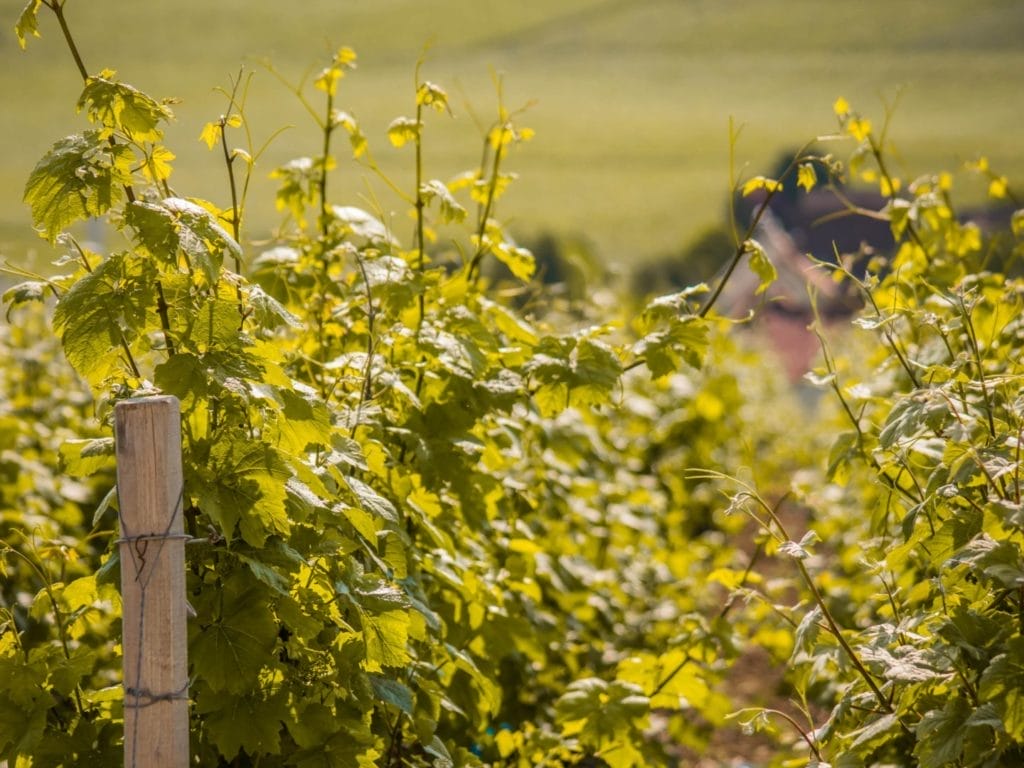
While those three are the stars, five lesser-known grapes can also play a part in Champagne, However, these varieties represent a tiny percentage of the total vineyard area :
- Pinot Blanc
- Pinot Gris
- Petit Meslier
- Arbane
- Voltis
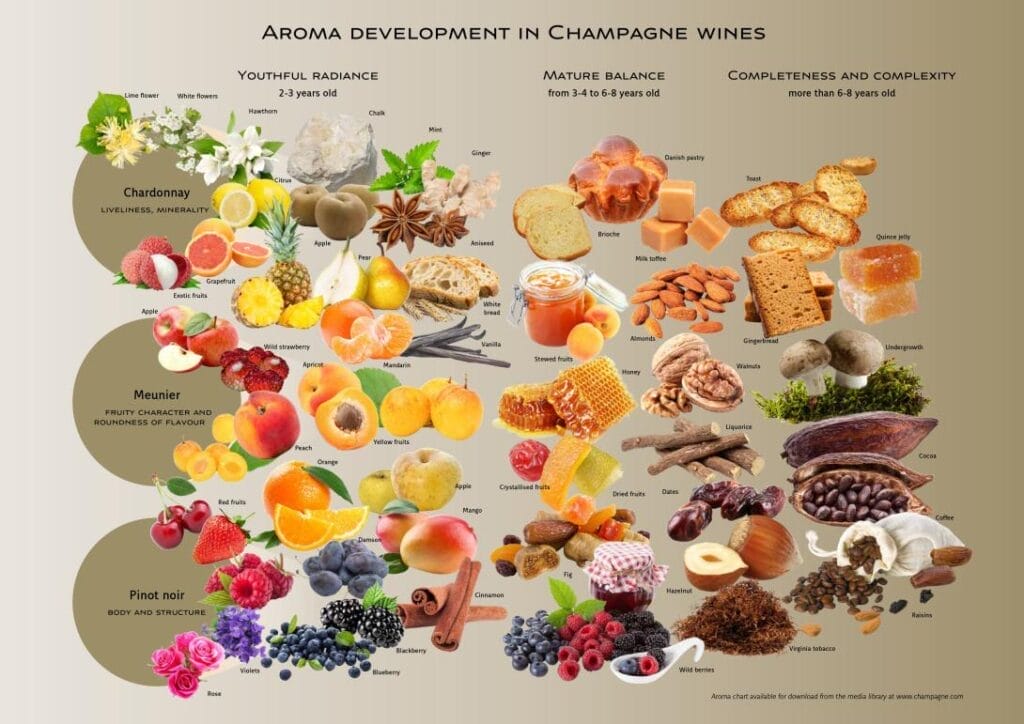
What areas make up the Champagne Region?
“Champagne” isn’t just a name; it’s a place. Only sparkling wine produced in this strictly defined region of France can legally be called Champagne. The Champagne region is divided into five main sub-regions, each with its unique characteristics and grape-growing conditions. Here’s a quick overview:
- Montagne de Reims: Dominated by Pinot Noir, this region produces robust and full-bodied Champagnes.
- Vallée de la Marne: Pinot Meunier thrives in this valley, lending a fruity and approachable character to the wines.
- Côte des Blancs: As its name suggests, this area is known for its Chardonnay and produces elegant, mineral-driven Champagnes.
- Côte de Sézanne: Similar to the Côte des Blancs, this smaller region also specializes in elegant Chardonnay Champagnes.
- Aube (or Côte des Bar): This southernmost region is planted primarily with Pinot Noir, known for its powerful and structured style.
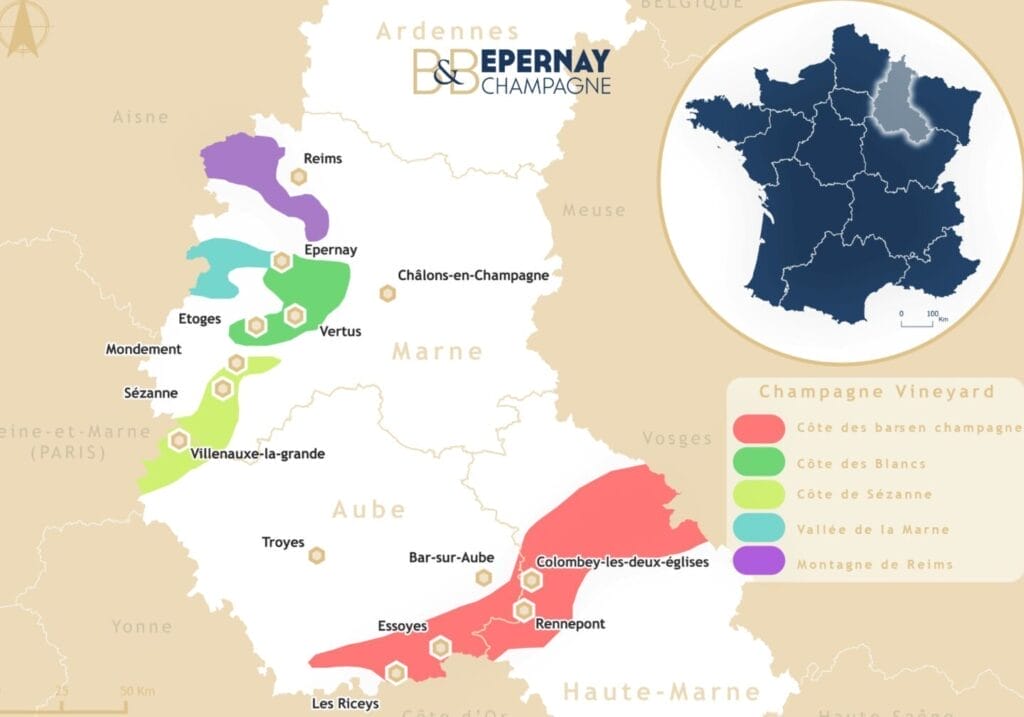
What is the difference between sparkling wine and champagne?
This is where things get really interesting! It’s a common misconception that all bubbly is “Champagne.” In truth, there are some key differences between sparkling wine in general and Champagne:
Region of production
Champagne must come from the Champagne region of France. Anything else is simply sparkling wine, even if made in the same style. Think Prosecco from Italy, Cava from Spain, or sparkling wines from California, Australia, and beyond.
Production method
Champagne is made using the traditional method, also known as “Méthode Champenoise,” which involves a second fermentation in the bottle. This process is what creates those fine, persistent bubbles Champagne is known for. While some sparkling wines use this method, others, like Prosecco, use the Charmat (or tank) method, resulting in larger bubbles and a fruitier profile.
Regulations
Champagne production is incredibly strict. Everything from the grape varieties to the pruning techniques to the minimum aging time is controlled by the Comité Champagne. This ensures a high and consistent quality. Sparkling wines, on the other hand, have more flexible regulations depending on their origin.
Price and prestige
Let’s be honest, “Champagne” carries a certain je ne sais quoi. This is partly due to its unique history, the strict production methods, and the limited geographical area. As a result, Champagne often comes with a higher price tag and is associated with luxury and special occasions.
Where to stay in Champagne Region ?
Book the best accommodation in top Champagne towns
Epernay
Reims
Hautvillers
Ay
This article contains affiliate marketing: this means that I get a small commission on the Booking links.
This allows the blog to live (translation, etc.) however it does not increase the price for you.
How to serve champagne ?
Knowing how to properly serve Champagne elevates the experience from “popping bottles” to true enjoyment. Follow these tips to impress your guests (or treat yourself!):
- Temperature is key: The ideal serving temperature for Champagne is between 8°C and 10°C (or 46°F and 50°F).
- Freezer? Non merci! Never put a bottle of Champagne in the freezer. The extreme temperature change can harm the flavor and quality of the wine.
- Ice bucket to the rescue: To chill a bottle quickly, use an ice bucket filled with water and ice. Submerge the bottle for 20 to 30 minutes, and it will reach the perfect temperature gently.
- Preserve the bubbles: Once opened, be sure to use a Champagne stopper to seal the bottle and store it in the refrigerator. This will help preserve its freshness and fizz for a few more days.
- Open quietly: For a touch of class, open Champagne silently, rather than with a loud pop.
If you want to learn more about common mistakes to avoid to enjoy your bubbly with style, check out our article on champagne mistakes to avoid.

What is the best glassware for champagne?
Believe it or not, the glass you choose can dramatically impact your Champagne experience. While those tall, slender flutes might be the go-to in many settings, they’re not actually ideal for savoring Champagne’s complex aromas.
- Ditch the flute: Flutes might look elegant, but they don’t allow enough space for the aromas of the Champagne to develop fully. The narrow opening traps the bubbles but doesn’t give your nose much room to explore the more subtle scents.
- Embrace the tulip: The best option for tasting is a tulip glass. Shaped like, well, a tulip flower, this type of glass has a wider bowl that narrows at the top, allowing the aromas to collect and concentrate. This means you get a more intense and nuanced sensory experience.
- White wine glass works too: Don’t worry if you don’t have a dedicated set of tulip glasses. A standard white wine glass is a perfectly acceptable alternative. The key is to use a glass with a wide base and a slightly tapered top to best capture and enhance those wonderful Champagne aromas.
Some Champagne houses or independent winemakers still serve in flutes, mainly because it’s what people expect when they visit. As for others, well… maybe they just have a surplus of them, so feel free to help them reduce their stock – just kidding!
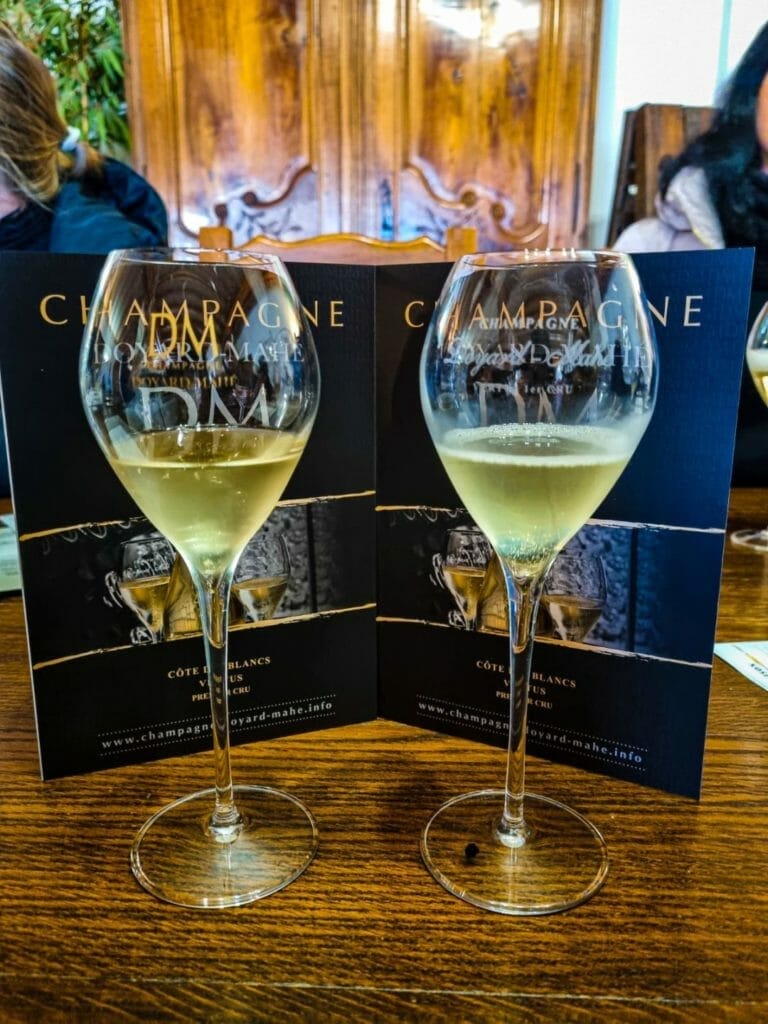
Where do the bubbles in champagne come from?
Those delightful bubbles are what make Champagne so festive and celebratory! But have you ever stopped to wonder where they actually come from? It’s not magic (though it might seem like it!). Here’s the science behind the fizz:
The bubbles in Champagne are created through a fascinating process called secondary fermentation. This is where Champagne differs from still wines.
- Initial Fermentation: Like all wines, the journey from grape to glass begins with fermentation. In this first stage, yeast converts the natural sugar in the grapes into alcohol. This creates the base wine—which at this point, is not yet bubbly.
- Secondary Fermentation: To create those signature bubbles, the base wine undergoes a second fermentation. This time, it’s bottled with a mixture of additional sugar and yeast. This triggers a transformation inside the bottle. As the yeast consumes the sugar, it produces two byproducts: alcohol (which increases the alcohol content slightly) and carbon dioxide—those precious bubbles!
- Trapped Bubbles: Here’s where it gets really interesting. Because the bottle is capped, the carbon dioxide has nowhere to escape. The pressure inside the bottle builds, and the gas dissolves into the liquid, creating the effervescence—that beautiful sparkle and fizz—that Champagne is known for.
- Riddling and Disgorgement: After the secondary fermentation is complete, the bottles go through a couple of final steps. First, they’re gradually rotated and tilted (a process called riddling) so that the now-inactive yeast sediment collects in the neck of the bottle. Finally, the sediment is removed (disgorgement), and the bottle is sealed with a cork, ready for your enjoyment.
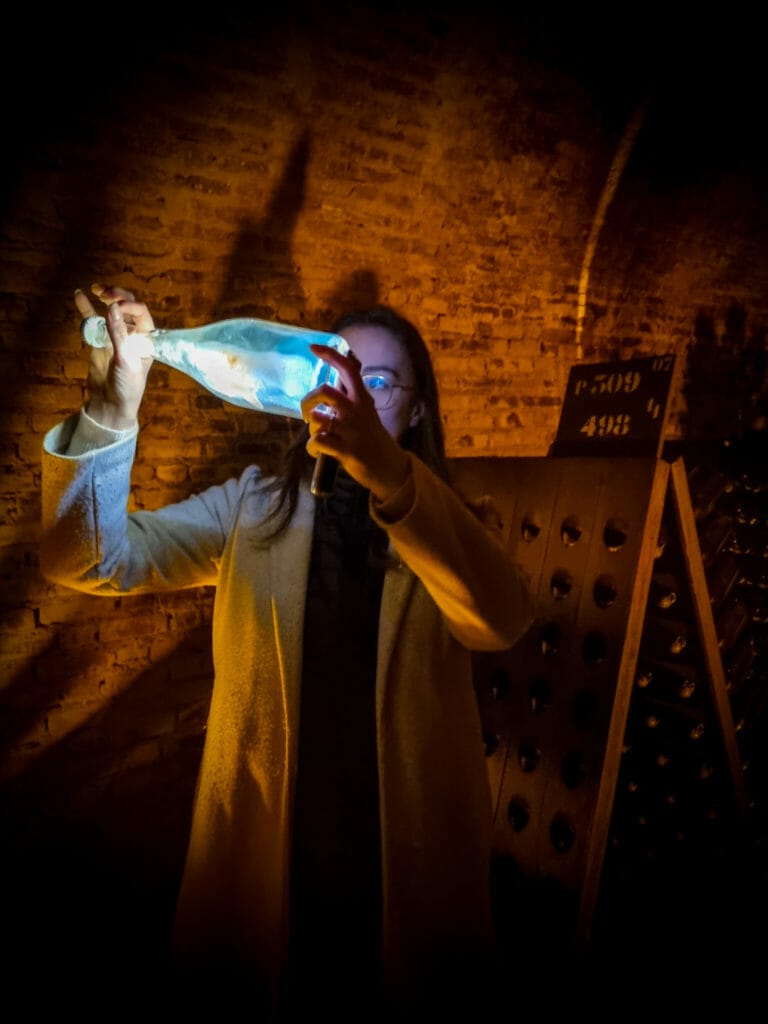
What’s the difference between champagne styles?
Walking into a Champagne bar or browsing a wine shop can be a little overwhelming. There are so many styles to choose from! But don’t worry; understanding the key factors that differentiate Champagne styles will help you make the perfect choice.
Champagne style factors:
- Grape Varieties: As we learned earlier, Champagne is made primarily from Chardonnay, Pinot Noir, and Pinot Meunier. The blend of these grapes—or the use of a single variety—will significantly influence the Champagne’s taste and character.
- Dosage: Dosage refers to the small amount of sugar solution added to Champagne after the second fermentation and disgorgement. The dosage level determines the Champagne’s sweetness, ranging from bone dry to luxuriously sweet.
- Aging: The length of time Champagne spends aging in the bottle impacts its complexity and flavor development.
- Winemaking Techniques: Aspects like the use of oak barrels during aging can also impart unique characteristics to the final product.
Let’s break down some of the most common Champagne styles:
By grape variety:
- Blanc de Blancs: Literally meaning “white of whites,” this style is made exclusively from Chardonnay grapes—white juice from white grapes! Blanc de Blancs Champagnes are known for their elegance, finesse, and notes of citrus, white flowers, and minerality.
- Blanc de Noirs: This one sometimes throws people off. “Blanc” means “white,” yet these Champagnes are made from black grapes—typically Pinot Noir and/or Pinot Meunier. The trick is that while these grapes have dark skins, their juice is clear! Blanc de Noirs Champagnes offer a richer style with more body and aromas of red berries, spice, and sometimes a hint of toastiness.
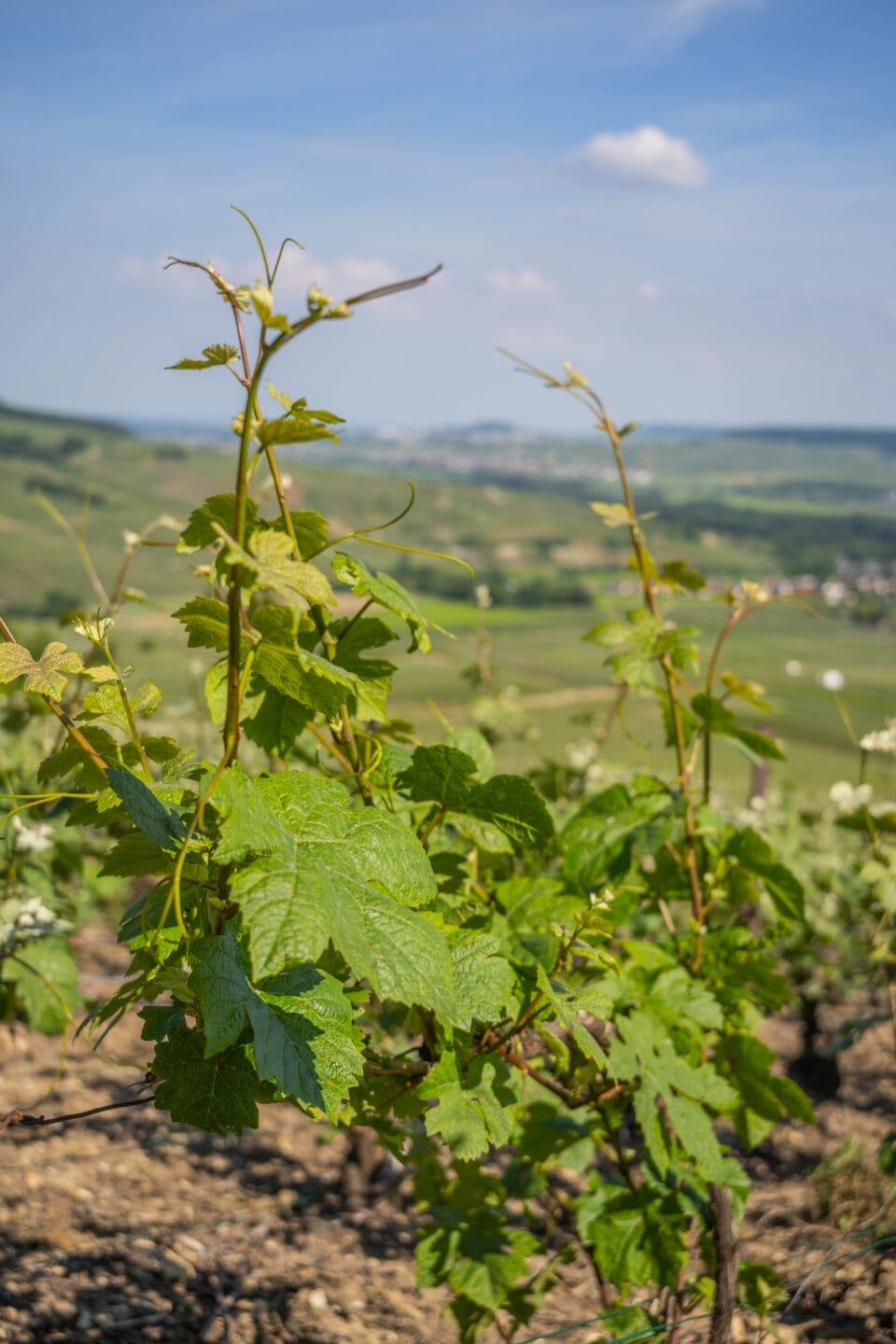
By dosage:
- Brut Nature/Zero Dosage: This is the driest style of Champagne, with no sugar added during dosage. Expect a crisp, clean palate with pronounced acidity.
- Extra Brut: Also very dry, Extra Brut Champagnes have a tiny amount of sugar added, but they are still incredibly crisp and refreshing.
- Brut: This is the most common style of Champagne. It offers a balance of freshness and fruitiness with a hint of sweetness.
- Extra Dry: Don’t let the name fool you! “Extra Dry” is actually slightly sweeter than Brut but still considered a dry style.
- Sec: Noticeably sweeter than the Brut styles, Sec Champagnes offer a more pronounced sweetness that pairs well with a range of dishes.
- Demi-Sec: This translates to “semi-sweet,” Demi-Sec Champagnes have a more pronounced sweetness and are often enjoyed with desserts.
- Doux: The sweetest of them all, Doux Champagne is rich, decadent, and best paired with very sweet treats.

Other styles:
- Rosé Champagne: Beloved for its beautiful pink hues, Rosé Champagne is made by either adding a small amount of still red wine to the blend or by allowing the juice of black grapes to macerate (sit in contact with the skins) for a short period. Expect aromas of red berries, citrus, and sometimes a subtle floral note.
- Vintage Champagne: Only made in exceptional years, Vintage Champagne is crafted from grapes harvested in a single year. These Champagnes are aged for longer periods, resulting in more complex and nuanced flavors.
- Non-Vintage Champagne: The majority of Champagne is non-vintage, meaning it’s a blend of wines from different years. This allows Champagne houses to create a consistent “house style” year after year.
- Oak Barrel-Aged Champagne: While not as common, some producers age a portion of their Champagne in oak barrels. This imparts additional complexity and aromas of vanilla, spice, and toast.
To learn how to choose the Champagne that best suits your taste, feel free to check out our simple and effective guide: how to choose your Champagne.
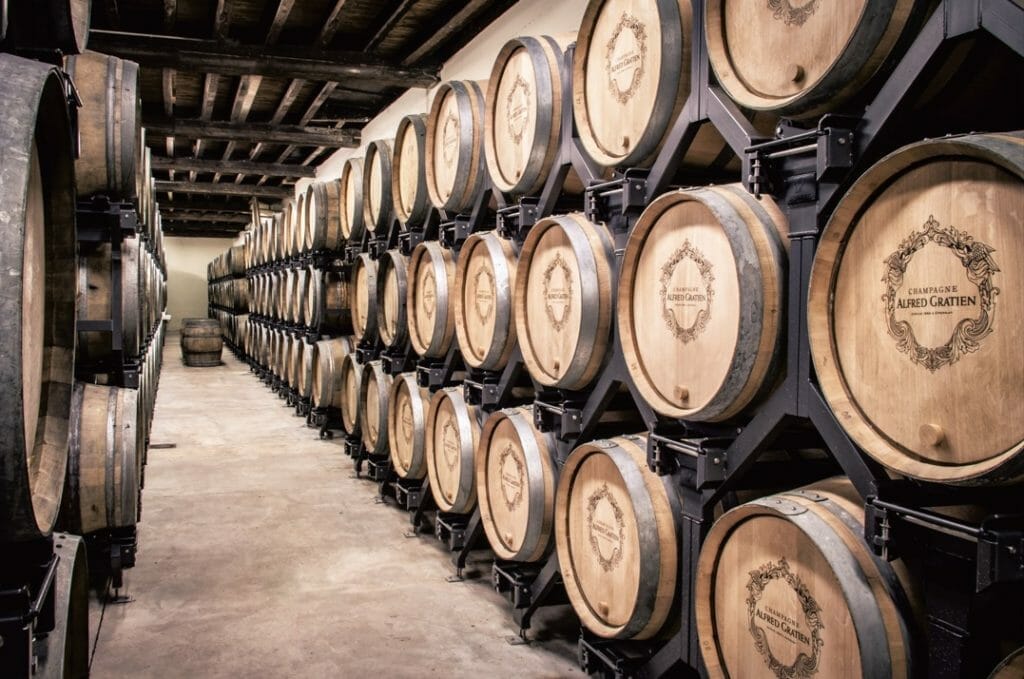
So there you have it! I could talk about Champagne all day (and often do!), but I hope this article has given you a clearer understanding of what makes this sparkling wine so special. Writing about Champagne without getting bogged down in technical terms can be tricky – we Champenois have our own way of talking about things, don’t we? But my aim was to make this information accessible and enjoyable for everyone, whether you’re a seasoned Champagne sipper or just starting to discover the joys of this incredible drink.
If you’re eager to learn even more, the Comité Champagne website is a fantastic resource packed with detailed information about everything from grape growing to production methods to the history of the region.
Now that you know a bit more about where Champagne is made, the different styles, and how it’s best enjoyed, I hope you’ll feel confident exploring the world of Champagne further. And if you ever find yourself in the Champagne region, be sure to stop by the B&B. Cheers! 🥂